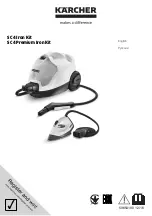
3. Push the light out through front of power box.
4. Push the new light into the power box.
5. Connect the wiring to the LED terminals on the power
board. P3 - red; P4 - black. Route the wires away
from the high voltage wires or contacts.
6. Replace cover.
7. Return power to Air Cleaner. Test light.
Replacing A Power Board
Before replacing the power board, turn
OFF
power to
the Air Cleaner at the source or remove the plug.
1. Remove the power box cover.
2. Disconnect wiring from the LED, HV1, HV2 and 24 V
terminals. Make note of position of wires.
3. Remove the three hex nuts from the power board.
4. Remove the power board from the studs.
5. Place the new board onto studs with the 24 volt input
close to the transformer.
6. Replace the hex nuts removed in Step 3. Ensure the
star washer is in place over the steel spacer at the
ground location on the power board. For proper
grounding the washer must be located on the top of
the steel spacer, under the power board.
7. Reconnect wiring to LED, HV1, HV2, and 24 V
terminals on the new power board. See Fig. 5.
8. Return power to Air Cleaner. Test power board.
9. Replace power box cover.
Note:
The power board has been set before shipping. It
is not usually necessary to reset the voltage to the new
load. If you do need to adjust the voltage refer to Setting
Voltage of Power Board section for more information.
Testing Air Proving Switch (APS)
The APS sensor must sit in the plastic bushing to
operate correctly.
The sensor is very sensitive and
operation may be affected by cold ambient temperatures,
an air exchanger, or a fresh air duct connected to the
return air duct just upstream of the Air Cleaner.
The APS uses a Triac in its output circuit, which
affects the voltage sine wave. Using a regular digital
voltmeter may give a false reading. To check the output
from the APS, use a true RMS (root mean square) meter
to measure the output at terminals 1 and 4 of the APS.
The output should be between 210 and 240 VAC,
depending on the airflow across the sensor.
A 220 volt neon lamp may be used to test the output
of the APS. Place the leads of the lamp across terminals
1 and 4 of the APS. If the lamp lights, the voltage is
sufficient for operation.
Do not use performance light.
When the Air Cleaner is turned on without airflow, the
APS sensor heats up, and after 20-30 seconds opens the
circuit to turn off the power board. When the fan starts up
(the sensor is cooled), the circuit will close, the power
board is turned on, and the performance light will come
on.
The light on the power switch will be lit even when
the APS is open.
If the power board fails to come on with the fan on,
check that the sensor is properly set down, to the bottom
of the plastic bushing, in the front of the power box. To
check the APS for proper operation remove the collecting
cells, turn the unit
ON
without the fan on. The power
board should come on immediately, and then turn off in
20-30 seconds as the sensor heats up. To check sensor,
blow directly on it lightly. This should activate the power
board within 10 seconds. Service the sensor carefully.
The sensor leads are 220 V. If the APS does not turn the
power board and performance indicator on, by-pass the
APS by placing a jumper between wires 3 & 4 on the
APS. This removes the APS from the circuit.
See Troubleshooting Guide for more information.
Note:
If the air flow through the Air Cleaner is less than
360 CFM the APS sensor may not have enough air flow
to activate the Air Cleaner. See Wiring for information
how to wire the Air Cleaner to the EAC module of the
system. In very low air applications the Air Cleaner may
need to be wired through the EAC contacts and the APS
disabled by connecting wires 3 & 4 together.
If there is no EAC module or it is not powered on low
speed then a relay will have to be installed to activate the
Air Cleaner when the fan starts. The APS will have to be
disabled.
Replacing An Air Proving Switch (APS)
Before replacing the APS, turn
OFF
the power to the
Air Cleaner at the source.
1. Disconnect wiring from terminals 1, 2, 3, and 4 on the
APS. See Fig. 5.
2. Remove the circuit board from the studs by removing
the two nuts. Do not remove the spacers.
3. Install the new APS on the studs and secure with the
nuts. Ensure sensor protrudes only to the bottom of
the plastic bushing.
4. Connect wiring to terminals on APS. See Fig. 5.
Wiring from the power switch is connected to
terminals 2 and 3. Wiring to the transformer is
connected to terminals 1 and 4.
5. Test the new APS.
Testing The 24 V Transformer
1. Remove power box cover.
2. Disconnect the leads of the 24 V transformer from
the power board. See Fig. 5. Do not short leads.
3. The Air Cleaner should be
ON
. The system fan
should be running on high speed. The access door
should be closed.
4. Measure voltage across the leads with a voltmeter.
Voltage should read 25 - 28 VAC.
5. If no voltage is present, check operation of the APS.
6. Reconnect leads to the power board.
7. Replace power box cover.
Replacing The 24 V Transformer
Before replacing the transformer, check the
resistance across the power board 24 V input terminals,
8
Содержание SASD10-2
Страница 14: ...NOTES 14 ...


































